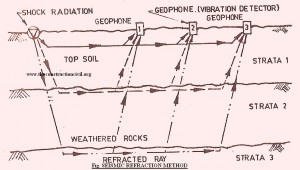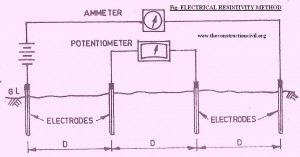Geo-Physical Method of Soil Exploration
Geo-physical methods are used when soil exploration is to be carried out over large area and where speed is of prime importance. These soil exploration methods are based on principle that physical properties like electrical conductivity, elasticity or seismicity, magnetic susceptibility, density etc. vary for different types of soils. There are four soil exploration methods of geo physical survey, namely, (1) Seismic refraction method (it) Electrical resistivity method, (iit Magnetic method and (ivy Gravitational method. However, out of these only two methods namely (1) Seismic refraction method and (ii) Electrical resistivity method are widely used.
(i) Seismic Refraction Method: This soil exploration method is based on the principle that sound waves travel faster in rock than in soil. This is on account of the fact that velocity of sound waves is different in different media. In this method shock waves (or sound waves of vibration) are created into the soil at ground level or at a certain depth below it, either by striking a plate on the soil with the hammer or by exploding small charge in the soil. The shock waves so produced travel down in the sub-soil strata and get refracted after striking a hard rock surface below. The refracted or radiated shock waves are picked up by the vibration detector (also known as geophone) where the time of travel of the shock waves gets recorded. Knowing the time of travel of the primary and refracted waves at various geophones, tune and distance graphs are drawn based on which it is possible to evaluate the depth of various strata in the sub-soil. Different materials such as clay, gravel, silt rock, hard rock etc. have characteristics seismic velocities and hence it is possible to establish their identity in the sub-soil based on time distance graph.

(ii) Electrical Resistivity Method: This soil exploration method is based on the principle that each soil has different electrical resistivity, depending upon the type of soil, its water content, compaction and composition. Thus saturated soil has lower electrical resistivity as compared to loose dry gravel or solid rock. In this method 4 electrodes are driven in the ground at equal distance apart and in a straight line. The distance between two electrodes being the depth of exploration or depth up to which the ground resistance is to he measured. A current is passed between the two outer electrodes and the potential drop between the inner electrodes is measured by use of potentiometer.

The mean resistivity is calculated by the following formula:-
P = 2 π D (E/I)
Where,
P = mean resistivity (ohm.cm)
D = distance between electrodes (cm)
E =potential drop between inner electrodes (volts)
I = current flowing between outer electrodes (amperes)
Average value of resistivity for various types of soils have already been established based on tests. Thus on knowing the values of change in mean resistivity of sub-soil strata at site, it is possible to establish the nature and distribution of different type of soils in the formation.
